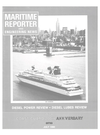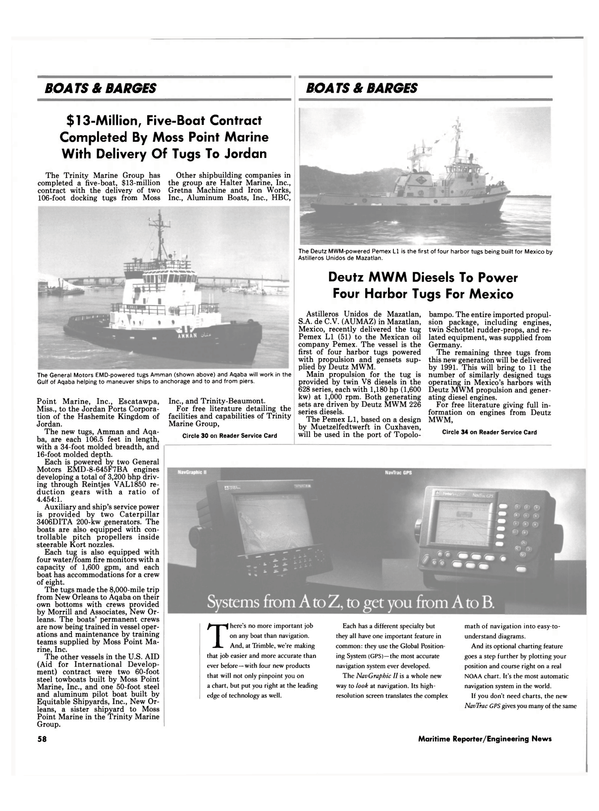
Canadian Government Report And New U.S. NOAA Administrator Publish Strong Swath Endorsements
The Canadian Department of Fisheries and Oceans, following extensive trials of the Swath Ocean® vessel Frederick G. Creed in the North Atlantic this past winter, has released a report which strongly endorses employing the swath vessel in hydrographic survey, economic zone patrol and oceanography roles.
In a paper recently presented to Hydro USA 90—an international body of hydrographers at Norfolk, Va., sponsored by the U.S. National Oceanic and Atmospheric Administration (NOAA) and The Hydrographic Society of America—the Canadian authorities concluded that the 80-ton aluminum vessel, of the small waterplane area twin hull type, "permit the collection of bathymetric data at an unprecedented rate even in poor sea conditions." In assessing overall performance, the Canadians found that in contrast to all vessels they had previously em- ployed, the Swath Ocean 2000 Class vessel was "smaller in displacement, faster, operated by a smaller crew and operated more efficiently in deteriorating sea conditions, resulting in a much larger operational weather envelope." The Frederick G. Creed was designed and built by Swath Ocean Systems, Inc., of Chula Vista, Calif., launched October 1989, and is the fourth in its series of swath vessels.
She is approximately 67 feet in overall length, 32 feet in beam, draws 9.5 feet and has a top speed of 25 knots with a cruising speed of 21 knots.
From December 1989 to the present, she has been operated under charter and evaluated in a joint U.S./Canada Hydrographic Commission project.
Canada is now in the process of buying the vessel.
In the keynote address to the symposium—with an audience which included the top-ranking hydrographers of the Canadian, Fiji and Norwegian Governments and of the American, Argentinian, Dutch, Indian, Italian and Peruvian navies— newly appointed U.S. Under Secretary of Commerce (for Oceans and Atmosphere) John A. Knauss made an unusually strong prediction about how swath vessels like the Creed would support advanced mapping technologies such as global position systems (GPS) and multibeam systems: "Most expect that modern sonar technology coupled with the accuracy of GPS, all used aboard small, but highly stable swath vessels, the results fed directly into computer derived 'boat sheets', will soon produce a revolution in charting efficiency and effectiveness even more spectacular than S w a t h Ocean S y s t e m s of Chula Vista, Calif., is those generated by . . . systems introduced after World War II." Swath Ocean have production affiliates in the U.S., Canada and in Europe and currently market the 2000 Class vessel for use in hydrographic survey, patrol, light oceanography, marine pilot and small passenger carriage roles. Swath Ocean also have a high-speed all-passenger ferry with 30-knot/450-passenger capacities and a steel-hulled RO/RO ferry able to carry 500 passengers and 125 cars at a loaded service speed of 36 knots.
For free literature containing further information on Swath Ocean International, C i r c l e 4 0 o n Reader S e r v i c e Card
Read Canadian Government Report And New U.S. NOAA Administrator Publish Strong Swath Endorsements in Pdf, Flash or Html5 edition of July 1990 Maritime Reporter
Other stories from July 1990 issue
Content
- Wartsila Diesel Announces Executive Appointments page: 10
- Chandris Celebrity's 'Horizon/ Built By Meyer Werft, Makes Her New York Debut page: 11
- Furuno Introduces New Autopilot, Compact, Lightweight Gyrocompass, And 10-Inch Color Video Sounder page: 11
- Radio Holland's Datamation: A Complete Integrated Ship Management System page: 13
- McDermott Awarded $27-Million Exxon Contract For Offshore Platform page: 13
- Avondale To Bid On Construction Of World's Largest Passenger Ship page: 14
- Singmarine Wins $16 Million Contract For New Chemical Tanker page: 15
- Hamilton Introduces Advanced Water Jet For Wide Range Of Vessels page: 16
- Halter Marine To Convert Supply Vessel For EPA Under $4.2-Million Pact page: 18
- Magnavox Introduces New Integrated GPS/Transit Satellite Navigation System page: 18
- Leevac Shipyards A w a r d ed Supply Boat Contract page: 19
- DIESEL POWER REVIEW page: 20
- MARINE LUBRICANTS page: 28
- U.S. Coast Guard Celebrates 200 Years Of Service page: 33
- Our Third Century page: 34
- Overview Of Coast Guard's Fiscal Year 1991 Request page: 36
- Willard Marine Continues Work With U.S. Coast Guard; Introduces SOLAS-Approved 18-Foot RIB page: 42
- Bollinger Receives $73.4-Million Modification To Build USCG Patrol Boats page: 42
- Morgan Crane Receives Order For Knucklebooms For Three Corvettes page: 43
- New Navy Report Outlines Potential Submarine Threat From Third World Nations page: 44
- US Navy Homeports Select Seaward Marine Fenders page: 44
- NORSHIPCO Completes Conversion of Crane Ship (T-ACS 9) For Navy page: 45
- Tano Marine Named Single System Vendor For T-AGS 45 page: 45
- Marinette Marine Launches Its Third MCM Vessel USS Patriot (MCM-7) page: 46
- Essex Machine Works Delivers New Steel Propeller Shafts For Coast Guard's 'Eagle' page: 48
- Viking Seminar Updates Skills of Service Representatives page: 48
- Global Marine Group Changes Company Name To GMG Systems, Inc. page: 53
- Robert Allan-Designed Hydrographic Survey Vessel Delivered By Allied Shipbuilders page: 54
- Aluminum Boats Constructing 140-Foot Dinner Yacht For Chicago page: 54
- Bender Awarded $3-Million Contract For Drill Rig Repair page: 55
- Cummins Diesels Power Cruise Vessel 'America' Delivered By Marine Builders page: 56
- ZF Introduces New Series Of Economical High-Horsepower Marine Transmissions page: 56
- $13-Million, Five-Boat Contract Completed By Moss Point Marine With Delivery Of Tugs To Jordan page: 58
- Deutz MWM Diesels To Power Four Harbor Tugs For Mexico page: 58
- Atlantic Marine Awarded $12.6-Million Contract To Build Three Sternwheel Dinner Vessels page: 59
- ABB Marine To Supply $50-Million Power Package To Fincantieri page: 59
- Blount Marine Delivers 192-Foot Dinner/Excursion Boat M / V Spirit Of Boston page: 60
- Canadian Government Report And New U.S. NOAA Administrator Publish Strong Swath Endorsements page: 61
- Master Marine Completes Repair, Maintenance On USCG Island Class Patrol Boats page: 62
- Trinity Marine To Build Three 220-Foot Supply Boats Under $15-Million Contract page: 62
- MTU-Powered High-Speed Catamaran, Built To New Flying Cat Design, Delivered By Kvaerner Fjellstrand page: 63
- COMSAT Expands Its Mobile Communications To New Ocean Region page: 63
- New Paint Factory For Sigma In Amsterdam page: 64
- Allied-Signal 'Spectra Shield' Panels For Marine Vessels Offer Maximum Ballistic Protection page: 64
- Textron Marine Systems Wins $6.5-Million Contract To Build Two SES Fireboats page: 65
- Congressional Conferees Near Compromise On Double-Hull Tanker Phase-In page: 66
- New Literature Available On Coffin Mechanical Seals For Turbo Pumps page: 67
- ABB Offers Eight-Page, Full-Color Brochure On Turbochargers page: 68
- Marco Shipyard Christens Fourth North Pacific Freezer Longliner page: 68
- Versatile Pacific Shipyards Uses N e w Launching Technique For Hydrographic Survey Ship page: 69
- L&C Associates Completes Deactivation Of M / V Cape Inscription page: 70


